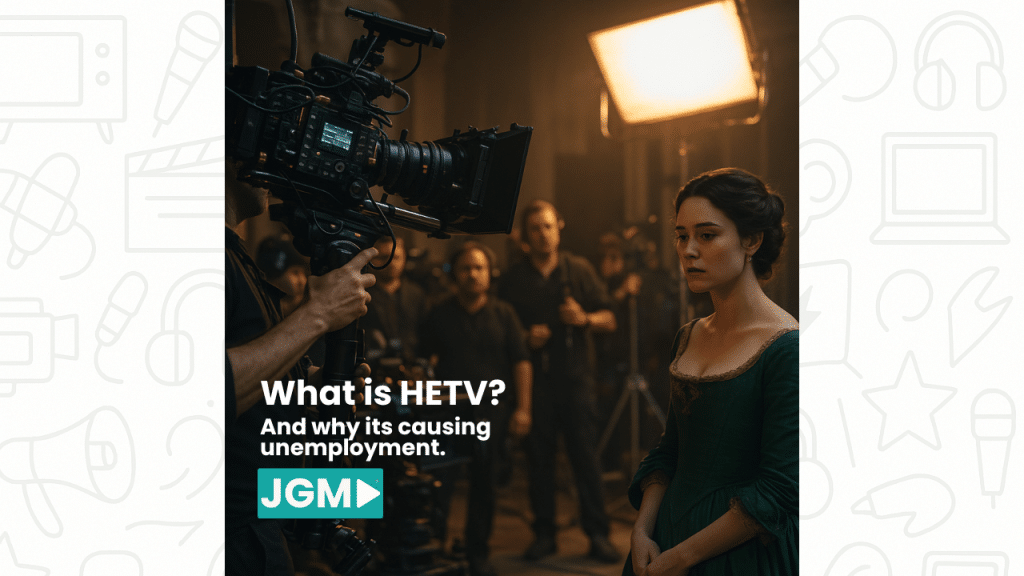Let’s talk about a term that gets thrown around a lot in UK production circles these days: HETV. High-End Television. It sounds glamorous. Prestige TV. Big budgets. Serious actors. Long shoot schedules. But dig a little deeper and it’s also a key driver of the industry’s current employment crisis and why so many workers are planning on leaving the industry.
Because while HETV has created a boom for a small slice of the workforce, it’s also contributed to a much wider bust for everyone else.
So let’s unpack what HETV really is, how it works, and why it’s become both a badge of honour and a barrier to employment.
What is HETV?
HETV stands for High-End Television, but it’s not just a marketing term. It’s a financial classification used by HMRC (and other governments) that comes with specific rules and, crucially, tax incentives.
In the UK, to qualify as High End TV, a show must:
- Be a drama, comedy, documentary or animation (not entertainment or reality),
- Be intended for broadcast or streaming,
- Cost at least £1 million per broadcast hour, and
- Pass the British cultural test (similar to what films must do to access UK tax relief).
When a show qualifies, it can claim up to 25% of UK production spend back in tax relief. That’s a massive deal — and it’s reshaped commissioning strategies at every major streamer and broadcaster.
Real-World Examples
Some of the biggest HETV titles of recent years include:
- “The Crown” – Netflix’s royal juggernaut, shot like a feature film.
- “House of the Dragon” – Sky/HBO’s Game of Thrones prequel.
- “Slow Horses” – Apple TV+’s spy drama with Gary Oldman.
- “His Dark Materials” – The BBC’s fantasy epic in partnership with HBO.
These shows are designed to look and feel like cinema. Massive sets. Huge crew bases. International locations. And they often shoot for 4–6 months for just 6–8 episodes.
What Makes a Show “High-End”?
It’s not just the money (though the £1m/hour threshold is the gateway). It’s also about how it’s made:
- Single-camera style, often shot like a feature film.
- Long prep and shoot periods — sometimes 10 days per episode.
- Cast and crew pulled from the top tier of the industry.
- High-end post-production, VFX, and scoring.
These are not the kind of shows you bash out in a few weeks in a studio. They’re prestige projects, and they come with all the trappings — and complications — that implies.
Why Do Streamers Love HETV?
Here’s where the economics come in. For platforms, HETV is:
1. Global
A slick drama with production value travels. HETV shows can be sold and streamed in dozens of territories. That means revenue well beyond the UK.
2. Branding Gold
“The Crown” doesn’t just get viewers — it gets awards, headlines and prestige. Platforms use these shows to build identity and legitimacy. They’re brand-defining.
3. Tax Efficient
That 25% tax rebate from HMRC? It’s not pocket change. On a £15m series, that’s nearly £4m straight back. It makes high budgets more palatable, and sometimes even profitable.
4. Subscriber Bait
Big glossy dramas are the ones that get people to sign up — or stick around. One buzzy HETV hit can do more than ten average shows when it comes to keeping a platform relevant.
So What’s the Problem?
Here’s the reality: HETV shows are massive — but rare. They take up huge resources for long periods of time. And that has knock-on effects for the wider industry.
1. Fewer Shows, Less Work
Traditional TV thrived on volume. Multiple shows, rotating casts and crews, lots of episodes, consistent employment. HETV flips that model. Now it’s fewer shows, made slower, by smaller teams. This is the “Less for More” economics or culture.
2. HETV Closed Circle Crew
Once a crew lands on an HETV gig, they’re booked for months. Often, the same crews go from one prestige project to the next. Great if you’re in. Brutal if you’re not. For newer or mid-career talent, there’s just less opportunity to get a foot in the door.
3. Mid-Budget TV is Dying
HETV has soaked up the budget, attention, and staff. As a result, the middle tier of TV — factual series, multicamera shows, daytime drama — is being squeezed. These used to be the training ground and bread-and-butter for the industry. Now, they’re drying up.
4. Feast or Famine
Streamers are cutting back. The era of “growth at any cost” is over. They’re commissioning less, but still sinking big money into a few high-impact titles. That means the pipeline has narrowed dramatically. It’s prestige or nothing.
The Bigger Picture, well it is High-End Television!
HETV has brought a lot of money and talent into the UK. It’s trained crews, upgraded infrastructure, and put UK production on the global map. Not that we weren’t already, renown for our production talent and craft. High End TV is here to stay some would say the UK is the home of HETV.
But the success of High End Television has also created an illusion: that the industry is thriving — when in fact, it’s becoming dangerously top-heavy.
We’ve ended up with an industry where only a handful of people are working consistently, while thousands of highly skilled professionals — directors, producers, camera ops, editors, runners — are sitting idle.
The result? A creative sector that looks healthy on paper, but is creaking under the surface.
Where Do We Go From Here?
This isn’t about killing off HETV. It’s about balance.
We need a TV landscape that supports volume as well as value. One that champions training and opportunity, not just prestige. One that understands that a thriving industry isn’t built on just six shows a year, no matter how glossy they are.
The challenge now is finding a way to sustain both ends of the spectrum — the cinematic and the serial, the expensive and the efficient. Because without that, HETV might just high-end itself into a very lonely corner. The TV manufacturers of course have a vested interest in the development of High End TV, it drives the upgrade market, more for less means more upgrades.
The Streaming Levy on High End Television?
Many campaigned but the DCMS have already said the streaming levy is not going to happen. The perception being the the levy is actually a tariff on High End TV, that may be so, but its a tariff that is applied in much of europe, and not applying one here is another incentive to shoot here. None of which helps the crisis in the Freelance workforce.
HETV – Conclusion
High End TV isn’t inherently bad — it has raised creative standards, brought cinematic ambition to the small screen, and turned the UK into a global production hub. But its dominance is unbalancing the ecosystem. When every show has to be a masterpiece, very few get made — and that leaves thousands of highly skilled people out of work.
The challenge ahead is to recalibrate. To find a sustainable balance between prestige and productivity. To create space again for the mid-budget, mid-scale, highly watchable TV that built this industry in the first place.



